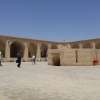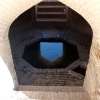Let's visit one of the most complete Safavid caravanserais, Meybod Shah Abbasi Caravanserai .
This caravanserai is located in Qazi MirHossein Boulevard, Imam Street, Meybod.
.jpg)
The Architecture of Meybod Shah Abbasi Caravanserai
It is one of the Safavid caravanserais which was built in Shah Abbas II period around 1067 SH with famous Safavid Style (brick building with four iwans).
Just opposite the caravanserai entrance, we can see the famous Kolar Aab Anbar (water reservoir) with four badgirs (wind tower). The inscription over the water reservoir depicts the date of 1070 SH. Since the water reservoir and the caravanserai are homogenous, it is said that both were constructed at the same time.
.jpg)
We can enter the main part of the caravanserai with 24 chambers from its southern side passing through its lofty and elegant door.
The first thing that catches our eyes is an octagon pool right in the middle of the caravanserai . Previously, a qanat ran through this building making the pool full of water, so the tired travelers could acquire their needed water.
.jpg)
What we can see in the caravanserai is a small part of the original building built in Safavid era. Like other caravanserais from Safavid era, this caravanserai includes an iwan, chambers, stables, eivanchehs, storage, and springhouse. The total number of the inner and outer chambers reaches to 100.
.jpg)
It is interesting to know that its skillful architects used wall heaters (similar to a fireplace) for heating the building and passive system of qanat thick pillars, reducing openings to outdoors, creating lofty spaces in outer edges of the building for cooling the building.
Willing to rest or eat food, we should go to the western side of the caravanserai . This part has been used as a traditional restaurant receiving Iranian and foreigner visitors.
.jpg)
Zilu Museum of Meybod
If you are interested in traditional carpets, do not miss the Zilu Museum which is located on the eastern part of the caravanserai. In the museum, you can find zeilos which are more than 500 years old. Zilo is a specific local carpet which is only woven in Yazd Province and especially in Meybod. Therefore, displaying zilos which are considered antique has made the museum unique in the country. The oldest piece of zilo kept in the museum is estimated to date back to 6 centuries ago which bears mihrabi patterns while the most valuable zeilo is the one with the design showing 24 prayer rugs which dates to 300 years ago. In additional to historical and old zilos, some newly woven zilos can be observed which are smaller in size than the older ones. Next to the Zeilo Museum, there is a training workshop where visitors can learn how to weave a zilo. Moreover, there are two other workshops in the courtyard displaying the tools and looms related to zeilo weaving which used to be regarded as one of the main industries in the area.
.jpg)
Chapar Khane of Meybod
There is another monument next to the caravanserai which is a post house ( Chapar Khane ). This post house dating back to Qajar dynasty has been recently rebuilt.
Meybod Shah Abbasi caravanserai and Post House were parts of Meybod Ribat.
.jpg)
Shah Abbasi Caravanserai was registered in Iran National Monuments on August 21, 1978 with registration No. 1618.
.jpg)
For more information about Shah Abbasi Caravanserai, please contact Raadina Online Support.
Online Support















.jpg)
.jpg)
.jpg)
.jpg)
.jpg)
.jpg)
.jpg)
.jpg)
